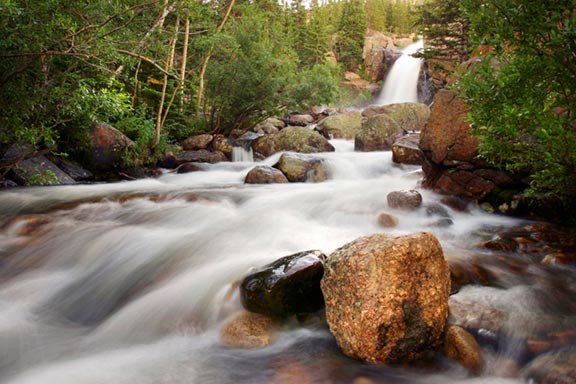
This photograph of Alberta Falls is an excellent example of how a slow shutter speed can create a soft, gentle silk like appearance to water.
The Silk Flow
Anyone who likes to spend time in the mountains or in a forest remembers an enjoyable time sitting alongside a cascading waterfall. The soothing rush of the water combined with the peace and relaxation of the mountains brings rest to a weary soul. Capturing that moment of rest with a camera can be challenging, but here are a few tips one can use while visiting the mountains.
Photographing the Flow of the Falls
First, a photographer needs to find a waterfall that is completely in shadow or covered by a light overcast. This serves two purposes. One, it allows a photographer to reduce the shutter speed being used. (I’ll discuss why one wants a slower shutter speed a little further in the article.) The second purpose is to have nice even lighting for your waterfall. Even lighting prevents hotspots on the lighter areas of the waterfall. The places where the sun reflects most brilliant off the water appear washed out in a photograph.
Secondly, use a slow shutter speed. The peaceful memory of the waterfall shows up best when one uses a shutter speed of a quarter second or less. This creates the soft, gentle silk like appearance to water. The best shutter speed to use depends on the desired affect and the speed of the water. I used a shutter speed of one second for the above shot of Rocky Mountain National Park’s Alberta Falls and a quarter second for the photograph of the Fall River cascade.
The series of photographs below of Calypso Cascades have the corresponding shutter speeds written on them. This shows the effect that different shutter speeds have on the water. These photographs also show the importance of keeping the subject in the shade. The cloud that covered the cascade moved away during the shoot. This caused greater contrast in the images that were photographed last. The direct sun washed out areas of whitewater
Fifthly, use a polarizing filter to reduce glare.
Now it’s your turn. I’d love to see your waterfall shots. Email me your photos at pmcenter-photos@yahoo.com. You can view more photo tips here.

